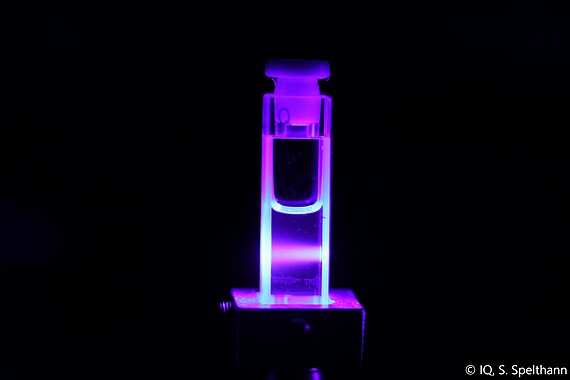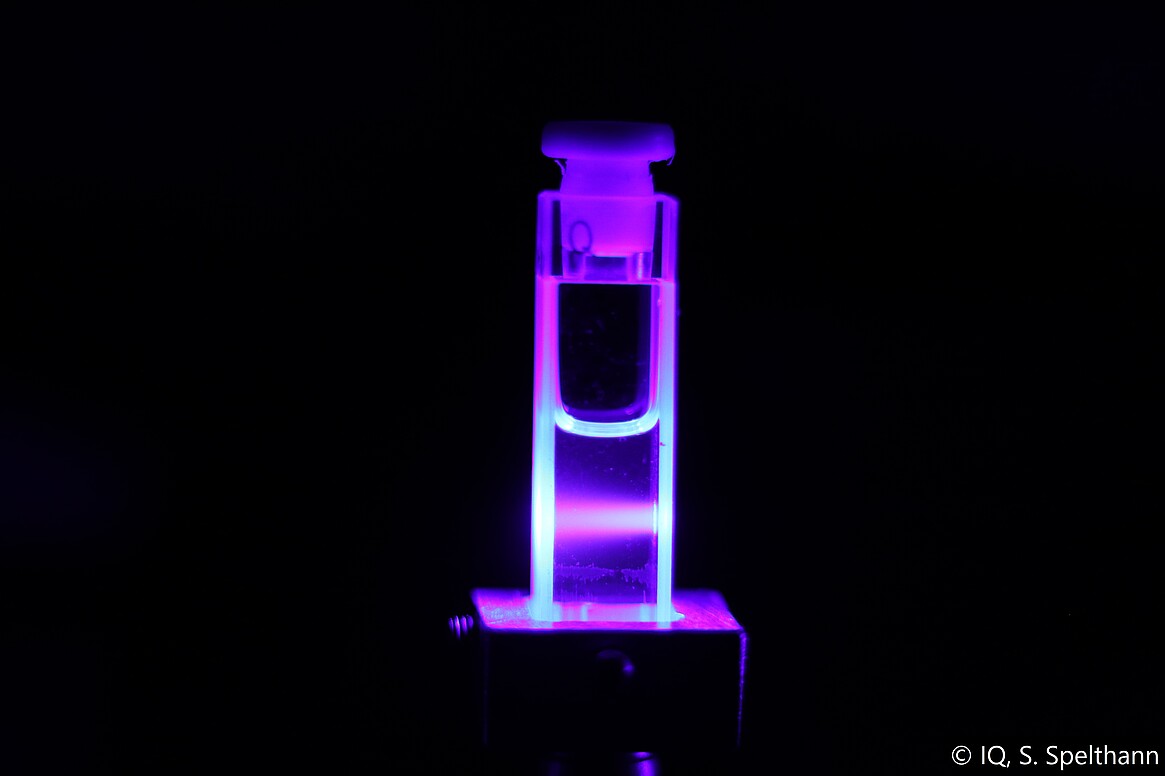Fibres and nanomaterials






The variety of solution-processed nanomaterials and the flexibility of their syntheses offer a broad range of novel optical functionalities. Together with our collaboration partners, we combine the exciting properties of such nanomaterials with both, established and novel types of fibres, which allows us to control the nanoparticle’s photonic environment and address novel applications.
One cornerstone of our work is the investigation of rare-earth-doped nanocrystals. We study their spontaneous emission and optimise them in terms of structure, size, and doping concentration for applications like novel gain media or quantum memories. For this purpose, we developed a numerical tool to study all relevant energy transfer mechanisms in nanocrystals. The numerical simulations are supported by extensive spectroscopic characterisation of particles synthesised by our collaborators. In addition to that, the nanocrystals’ spontaneous emission can be exploited to measure temperature. The so-called nanothermometry can be applied to determine the temperature under harsh environmental conditions such as strong magnetic or electric fields or with a spatial resolution below the diffraction limit. It makes use of the temperature-dependent Boltzmann distribution of two adjacent energy levels. Based on that, we fabricate fibre thermometers and apply them as temperature sensors, e.g. in proton-exchange-membrane-electrolysis cells.
We currently work with the following nanomaterials:
-
Rare-earth doped nanocrystals
We use fluoride-based systems such as the well-known NaYF4:Er,Yb nanocrystals. In these particles, near-infrared photons are absorbed by the Ytterbium ions. Energy from two or more of these ions is transferred to one Erbium ion resulting in so-called upconversion. The erbium upconversion emission yields two green transitions that we exploit for nanothermometry.
Replacing sodium with lithium, LiYF4 can be synthesized which is very well known from laser physics. When doped with Praseodymium ions, these nanocrystals emit several lines in the visible spectrum.
-
Carbon nanotubes
Carbon nanotubes are known for outstanding properties such as saturable absorption for mode-locking in ultrashort pulsed fibre lasers. Currently, carbon nanotubes need to be incorporated in polymer films and pressed between two fibre connectors to use them as ultra-fast switches which is complex and bulky compared to conventional fibre-based mode-locking schemes. We are working on an all-fibre integrated mode-locking device based on carbon nanotubes to reduce the complexity.
-
Plasmonic nanoparticles
Plasmonic nanoparticles synthesised from noble metals heat to extreme temperatures under laser excitation. These localised high temperatures can be exploited for catalysis and can be measured using nanothermometry. We are working towards the downscaling of gas catalysis reactors based on plasmonic nanoparticles incorporated in hollow core photonic crystal fibres.
-
Capillary fibres, metal-organic frameworks and nanoplatelets
Incorporating nanomaterial dispersions in capillary fibres allows us to modulate them and study their optical response. On the one hand, we investigate the modulation of the refractive index in fibres by using metal-organic frameworks (MOFs). On the other hand, we study the optical modulation of nanoplatelets for novel laser gain media and accompany the experimental results with numerical investigations based on rate equations.
-
Colloidal quantum dots
Colloidal quantum dots also exhibit excellent single photon emission characteristics. Many quantum metrology applications require single-photon streams to persist in a well-defined spatial mode. However, the lack of a suitable fibre coupling constitutes one of the main problems of such emitters. We work on the fibre integration of single-photon emitters based on colloidal nanomaterials.
Current projects
EMDeN - Development of an MCVD process for the doping of fused silica fibres with nanocrystals
FlexibleFunds in PhoenixD:
- with Behrens Group - Nanoscale MOFs in hollow core fibers
- with Lauth Group - Integration of optically active colloidal 2D semiconductor nanomaterials in hollow core fibers
Flexible Funds in QuantumFrontiers:
- with Ding Group - Fiber-integrated, efficient single photon sources for quantum metrology applications
Publications
Spelthann, S.; Thiem, J.; Melchert, O.; Komban, R.; Gimmler, Ch.; Demircan, A.; Ruehl, A; Ristau, D. (2023): Predicting the Excitation Dynamics in Lanthanide Nanoparticles, Advanced Optical Materials
DOI: https://doi.org/10.1002/adom.202300096
Spelthann, S.; Komban, R.; Steinke, M.; Ristau, D.; Ruehl, A.; Gimmler, C.; Welle, H. (2022): Bulk-like emission in the visible spectrum of colloidal LiYF4:Pr nanocrystals downsized to 10 nm, Nanoscale Advances
DOI: 10.1039/D2NA00045H
ISSN: 2516-0230
Spelthann, S.; Steinke, M.; Komban, R.; Weller, H.; Gimmler, C.; Ruehl, A.; Ristau, D. (2022): Colloidal LiYF4:Pr nanocrystals downsized to 10 nm – Part 2: spectroscopic properties, Europhoton 2022, Hannover, Poster THU-P-2.18
Spelthann, S.; Klepzig, L.F.; Huy Chau, D.; Chemnitz, M.; Junaid, S.; Stephan, R.; Hausmann, K.; Schmidt, M. A.; Lauth, J.; Steinke, M.; Ristau, D. (2022): Optical emission characterization of liquid core fibers filled with colloidal nanoplatelets, Europhoton 2022, Hannover, Poster TUE-P-1.27
Steinke, M.; Spelthann, S.; Rühl, A.; Ristau, D. (2021): Absorption and multi-phonon quenching in nanocrystal doped SiO2 fibers, Optical Materials Express 11, 1631-1642
DOI: 10.1364/OME.424116
Thiem, J.; Spelthann, S.; Neumann, J.; Ruehl, A.; Ristau, D. (2021): Three-dimensional nanothermometry below the diffraction limit, Optics Letters 46, 3352-3355
DOI: 10.1364/OL.423626
Thiem, J.; Spelthann, S.; Neumann, L.; Jakobs, F.; Johannes, H.-H.; Kowalsky, W.; Kracht, D.; Neumann, J.; Ruehl, A.; Ristau, D. (2020): Upconversion Nanocrystal Doped Polymer Fiber Thermometer, Sensors. 2020; 20(21):6048.
DOI: 10.3390/s20216048
Contact
30167 Hannover
















